5 to 30 Tons Overhead Crane for Precast Element Handling
Optimizing Precast Element Handling: The Role of Overhead Cranes
In the precast concrete production, efficiency is key. The seamless coordination of processes, from molding to stacking, plays a pivotal role in ensuring the quality and timely delivery of precast elements. At the heart of this intricate dance is the utilization of advanced machinery, with overhead cranes emerging as unsung heroes within the bustling walls of precast concrete plants.
Overhead cranes, with their suspended design and versatile functionality, have become indispensable in the realm of precast concrete manufacturing. These powerful machines traverse the manufacturing space with grace, lifting and transporting precast elements with precision. Unlike traditional floor based cranes, overhead cranes are affixed to a ceiling mounted runway system, providing an unobstructed view of the production floor.
The adaptability of overhead cranes extends beyond the simple lifting of heavy loads; these machines are engineered to integrate seamlessly into the complex workflows of precast concrete plants. From the initial stages of molding to the final stacking and storage of precast elements, overhead cranes serve as reliable workhorses.
In the precast concrete production, time is of the essence. The efficiency with which precast elements are handled directly impacts production timelines, product quality, and overall operational costs. Optimizing the handling of precast elements is not merely a matter of convenience; it is a strategic imperative for manufacturers looking to stay competitive in a demanding industry.
Precast elements, ranging from beams and columns to slabs, require careful and precise handling throughout their journey within the manufacturing facility. Any inefficiency in this process can lead to delays, increased labor costs, and potential compromises in the structural integrity of the final product. It is within this context that the role of overhead cranes becomes paramount.
Types of Cranes
In the intricate dance of precast concrete production, the choice of machinery is paramount. As we continue our exploration, let's delve into the world of overhead cranes, understanding their unique characteristics, comparing them with other crane types, and uncovering the specific advantages they bring to the handling of precast elements.
Overhead cranes, also known as bridge cranes, are a category of material handling equipment characterized by their elevated structure. These cranes are mounted on a runway system attached to the ceiling of a facility, providing a horizontal traverse along the length of the production area. The key components of overhead cranes include the bridge (the horizontal beam), hoist (the lifting mechanism), and end trucks (which allow movement along the runway).
The distinguishing feature of overhead cranes is their ability to lift and move heavy loads horizontally with precision. This suspended design ensures an unobstructed floor space, allowing for efficient material handling within the often confined quarters of a precast concrete plant.
In precast concrete plants, double girder overhead cranes play a crucial role in handling heavy and bulky precast elements. These cranes provide the necessary lifting capacity and precision required for the manufacturing processes. Here are some of the main types of double girder overhead cranes commonly used in handling precast concrete elements:
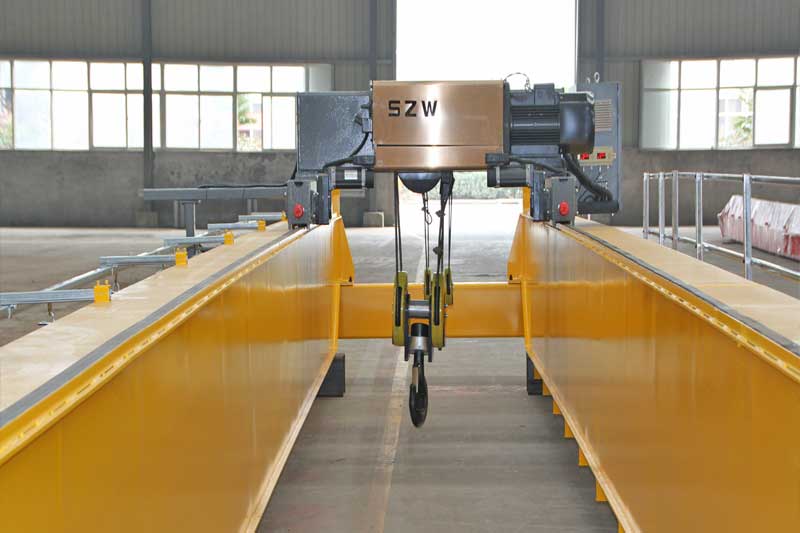
Electric Hoist Double Girder Overhead Crane:
Description: This type of crane incorporates electric hoists as the lifting mechanism. Electric hoists provide precise control over the lifting and lowering of precast elements.
Applications: Electric hoist double girder overhead cranes are commonly used in applications where precision and controlled movements are critical, such as the accurate placement of precast elements during the manufacturing process.
Benefits: Precise positioning, ease of control, suitable for applications requiring careful handling.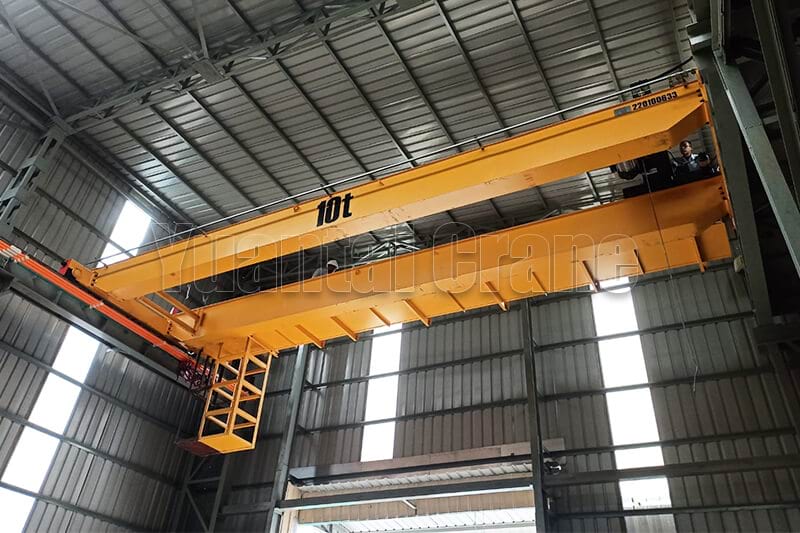
Open Winch Double Girder Overhead Cranes:
Description: Open winch double girder overhead cranes utilize an open winch as the lifting mechanism. The open winch design allows for easy maintenance and accessibility.
Applications: These cranes are well suited for heavy duty lifting tasks in precast concrete plants, providing reliability and durability in demanding industrial environments.
Benefits: Robust design, accessibility for maintenance, suitability for heavy duty applications.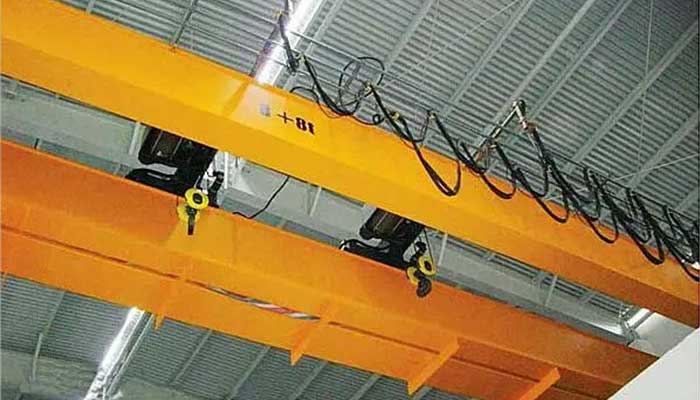
Double Hook Overhead Cranes:
Description: Double hook overhead cranes feature two hooks attached to the lifting mechanism, allowing them to lift and handle multiple loads simultaneously.
Applications: These cranes are suitable for scenarios where there is a need to lift and transport multiple precast elements in a single operation, improving efficiency and reducing handling times.
Benefits: Increased handling capacity, improved productivity in scenarios with repetitive lifting tasks.
Each type of double girder overhead crane has its unique features and advantages, and the choice depends on the specific requirements of the precast concrete plant. Factors such as the types of precast elements being handled, the need for simultaneous lifting, precision requirements, and the overall production workflow play a role in determining the most suitable type of double girder overhead crane for a given application. Manufacturers often select the crane type that best aligns with their operational needs to ensure efficient and safe precast concrete handling.
Comparison with Other Crane Types
While various crane types exist, each serving specific industrial needs, the overhead crane stands out in the precast concrete production landscape. Let's briefly compare overhead cranes with other common crane types:
Overhead Cranes vs. Gantry Cranes:
Overhead Cranes:Mounted to the ceiling, these cranes provide a higher degree of flexibility and precision in material handling.
Gantry Cranes:Supported by steel legs running on the floor, offering versatility in covering larger areas.
Overhead Cranes vs. Mobile Cranes:
Overhead Cranes:Ideal for repetitive and precision lifting within a defined space.
Mobile Cranes:Designed for portability and versatility, suitable for outdoor applications.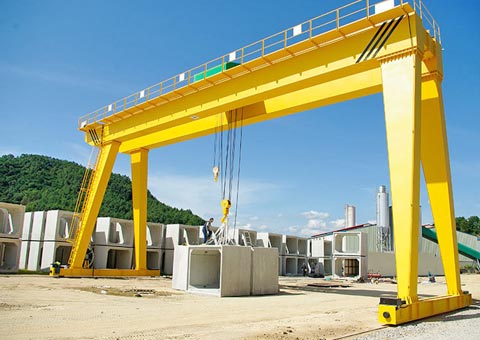
gantry crane for outdoor conceret block handling
Advantages of Overhead Cranes in Precast Element Handling
Overhead cranes bring a myriad of advantages to the table, making them the go to choice for precast concrete element handling:
- Precision and Control:Overhead cranes provide precise control over the positioning of precast elements during molding and assembly.The suspended design allows for accurate movement in three dimensional space, ensuring optimal placement.
- Efficient Use of Space:The overhead installation minimizes the footprint on the production floor, maximizing available space for other operations.Ideal for precast concrete plants where space optimization is crucial.
- Enhanced Safety:Overhead cranes, when properly operated, reduce the risks associated with ground level material handling.Operators have clear visibility of the entire workspace, minimizing the chances of accidents.
- Versatility in Load Handling:The 5 to 30 ton capacity range of overhead cranes caters to the varied weights of precast elements, allowing for versatile handling.Capable of lifting and transporting both lighter and heavier components with equal efficiency.
As we progress in our exploration of overhead crane operations in precast concrete plants, the unique advantages of these cranes will continue to unfold. Join us in the next installment as we delve into the specific loads handled by overhead cranes, their applications in different stages of production, and the tangible benefits they bring to the efficiency of precast concrete manufacturing.
Typical Loads Handled
As we navigate the intricate world of overhead crane operations in precast concrete plants, understanding the typical loads handled is paramount. In this segment, we'll delve into the specifics of precast beams, columns, and slabs – the building blocks of the construction industry – and explore why efficient handling of these elements is crucial for a seamless production process.
Description of Precast Beams, Columns, and Slabs
- Precast Beams:Beams are structural elements designed to carry loads transversely, typically spanning between columns or supports.
- In precast concrete plants, beams come in various shapes and sizes, ranging from simple rectangular beams to more complex shapes for specific applications.
- Precast Columns:Columns provide vertical support in a structure and are crucial for bearing the weight of beams and slabs.
- Precast columns are manufactured with precision to meet design specifications, and they come in diverse forms, including square, circular, or custom shapes.
- Precast Slabs:Slabs serve as horizontal elements covering spaces between beams and columns, forming the floors or roofs of a structure.
- In precast concrete plants, slabs vary in thickness, and their design can include reinforcements to meet structural requirements.
Importance of Efficient Handling for Different Precast Elements
Efficient handling of precast elements is not merely a matter of convenience; it directly impacts the overall efficiency and quality of the precast concrete production process.
- Optimized Workflow:Efficient handling ensures a streamlined workflow from the molding stage to final stacking and storage.
- Proper coordination minimizes downtime, accelerates production timelines, and enhances overall plant productivity.
- Reduced Labor Intensity:Overhead cranes shoulder the burden of lifting and transporting heavy precast elements, reducing the reliance on manual labor.
- Automation in handling processes leads to improved worker safety and efficiency.
- Quality Assurance:Precast elements must be handled with care to prevent damage or structural compromises.
Overhead cranes offer precise control, minimizing the risk of mishandling and ensuring the integrity of the precast elements.
Specific Challenges in Handling Various Precast Elements
- Variable Shapes and Sizes:Beams, columns, and slabs come in a variety of shapes and sizes, posing a challenge in terms of adaptability.
- Overhead cranes must be equipped to handle the diverse forms of precast elements effectively.
- Weight Disparities:The weight of precast elements can vary significantly, from relatively lighter slabs to heavier beams and columns.
- Overhead cranes with a capacity range of 5 to 30 tons are well suited to handle this diversity.
- Delicate Features:Certain precast elements may have delicate features or surface finishes that require careful handling.
- Overhead cranes provide the precision needed to navigate intricate details without causing damage.
Understanding the nuances of handling different precast elements is essential for manufacturers aiming to optimize their production processes. In the next installment, we will explore how overhead cranes excel in precise positioning during molding processes, the strategic transport of precast elements within the plant, and their crucial role in stacking and storage operations. Join us as we uncover the multifaceted applications of overhead cranes in the precast concrete industry.
Crane Applications
As we continue our exploration into the world of overhead crane operations in precast concrete plants, we now turn our attention to the diverse applications of these powerful machines. From the precision required during molding processes to the strategic transport of precast elements and their organized stacking and storage, overhead cranes play a pivotal role at every stage of the production process.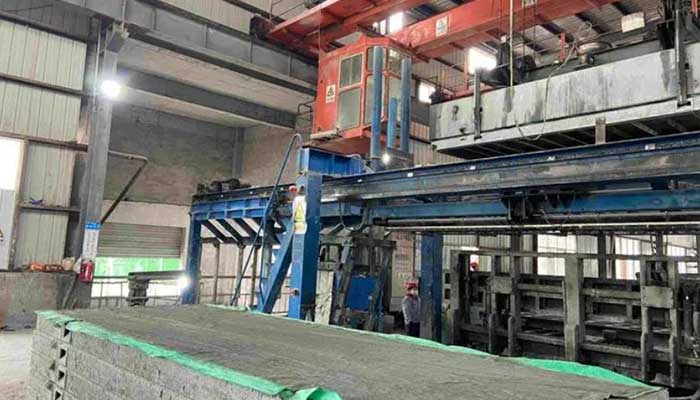 Precise Positioning during Molding Processes
Precise Positioning during Molding Processes
- Importance of Accuracy in Element Creation:Molding is the foundational stage in precast concrete production, where the shape and form of elements are determined.
- Accuracy is paramount to ensure that precast elements meet design specifications and quality standards.
- Role of Overhead Cranes in Ensuring Precision:Overhead cranes excel in the precise positioning of molds, ensuring that concrete is poured accurately.
The ability to move horizontally and vertically allows for optimal placement, contributing to the creation of high quality precast elements.
Transporting Precast Elements within the Plant
- Strategies for Safe and Efficient Transportation:Once precast elements are molded, safe and efficient transportation within the plant becomes crucial.
- Overhead cranes offer a bird's eye view, allowing operators to navigate through the facility while avoiding obstacles and ensuring the safety of both equipment and personnel.
- Overhead Crane Features Facilitating Transport:Variable speed controls and precise maneuverability enable smooth transportation of precast elements.
- Advanced features, such as automated controls and collision avoidance systems, enhance safety and efficiency in material transport.
Stacking and Storage of Precast Elements
Need for Organized Storage in the Production Area:Organized stacking and storage are essential for maintaining an efficient and clutter free production area.- Properly stored precast elements reduce the risk of damage and facilitate easy retrieval when needed for further processing.
- Overhead Crane Capabilities in Stacking Operations:Overhead cranes with specialized attachments facilitate the organized stacking of precast elements.
Precise control allows for the creation of stable and space efficient stacks, optimizing the use of the production area.
The multifaceted applications of overhead cranes in precast concrete plants underscore their significance in achieving operational excellence. From the inception of molding to the strategic transport and organized storage of precast elements, these machines contribute to the efficiency, safety, and precision that define a successful precast concrete manufacturing process.
General Crane Capacity Range: 5 to 30 Tons
In this segment, we explore the general capacity range of overhead cranes (5 to 30 tons) and delve into the significance of this specification. Understanding how this capacity range aligns with typical precast element weights and the flexibility it provides in handling various loads is crucial for manufacturers seeking to optimize their operations.
Significance of the Specified Capacity Range
- Balancing Strength and Versatility:The 5 to 30 ton capacity range of overhead cranes strikes a delicate balance between strength and versatility.It allows for the handling of a broad spectrum of precast elements, from lighter components like slabs to heavier structures such as beams and columns.
- Optimal Utilization of Resources:The specified capacity range ensures that overhead cranes are appropriately sized for the typical weights of precast elements encountered in the manufacturing process.This optimal matching of crane capacity with load requirements maximizes resource utilization and operational efficiency.
Matching Crane Capacity with Typical Precast Element Weights
- Adaptability to Various Element Weights:Precast elements come in diverse weights, with slabs being relatively lighter compared to the more substantial beams and columns.Overhead cranes within the 5 to 30 ton capacity range are designed to handle this diversity, providing manufacturers with a versatile solution.
- Efficient Handling of Specific Components:The specified capacity range allows overhead cranes to efficiently handle typical precast element weights, ensuring that the lifting and transportation processes are optimized for each component.
Flexibility and Adaptability in Handling Different Loads
- Handling Lighter Loads with Precision:The lower end of the capacity range (5 tons) allows for the precise handling of lighter precast elements, such as slabs.This level of precision is crucial during delicate phases like molding and assembly.
- Tackling Heavier Components with Ease:The upper end of the capacity range (30 tons) empowers overhead cranes to lift and transport heavier precast elements like beams and columns.This capability is essential for maintaining efficiency in the production of larger and more substantial structures.
- Adapting to Changing Production Needs:The flexibility inherent in the 5 to 30 ton capacity range allows manufacturers to adapt to changing production requirements.Whether handling a high volume of lighter components or fewer but heavier structures, overhead cranes in this range offer adaptability.
As we unravel the layers of overhead crane operations in precast concrete plants, the specific capacity range emerges as a critical factor in ensuring that these machines are not only powerful but also finely tuned to the unique demands of precast element handling. Join us in the next installment as we explore real world applications and case studies that demonstrate the effectiveness of overhead cranes in optimizing precast concrete manufacturing.
Case Studies and Examples
In this installment, we delve into real world applications, success stories, and lessons learned from the use of overhead cranes in precast concrete plants. These case studies provide tangible insights into how manufacturers have leveraged the capabilities of overhead cranes to achieve efficient precast element handling.
Real world Applications of Overhead Cranes in Precast Concrete Plants
- Precise Molding and Assembly:In a leading precast concrete plant, overhead cranes are employed for the precise positioning of molds during the molding process.The cranes facilitate the accurate assembly of precast elements, ensuring that each component meets the stringent quality standards of the plant.
- Efficient Transport Across Workstations:A mid sized precast concrete facility utilizes overhead cranes to transport elements seamlessly across different workstations.The cranes' ability to navigate through the production area with precision minimizes downtime, enhancing overall operational efficiency.
Success Stories Demonstrating Efficient Precast Element Handling
- Reduced Production Time in Beam Manufacturing:A precast concrete plant specializing in beam manufacturing implemented overhead cranes to optimize the handling of various beam sizes.The result was a significant reduction in production time, leading to increased throughput and overall efficiency.
- Enhanced Safety in Column Assembly:Another success story involves the use of overhead cranes for the assembly of precast columns.The cranes' advanced safety features and precise controls contributed to a reduction in accidents and an improvement in worker safety.
Get Your Custom Precast Conceret Handling Overhead Cranes
As we conclude our exploration into the integral role of overhead cranes in precast concrete plants, it's time to recap the applications, emphasize the specific capacity range, and reflect on the overall impact these machines have on the efficiency and productivity of the entire precast concrete production process.
The impact of overhead cranes on the efficiency and productivity of precast concrete plants is far reaching:
Time Efficiency:Overhead cranes contribute to streamlined workflows, reducing production time and enhancing overall plant productivity.
Resource Optimization:By efficiently handling precast elements within the specified capacity range, overhead cranes maximize resource utilization, minimizing both underutilization and strain on equipment.
Safety and Precision:The advanced features of overhead cranes, coupled with precise controls, enhance safety in operations and contribute to the accuracy required in precast element handling.
In essence, overhead cranes redefine the possibilities within precast concrete manufacturing, offering a harmonious blend of strength, precision, and adaptability.
As we wrap up this series, it's clear that overhead cranes are not just machines; they are orchestrators of efficiency, architects of safety, and pioneers of progress in the ever evolving landscape of precast concrete production. By leveraging the capabilities of overhead cranes, manufacturers are not only shaping the structures of today but also laying the foundation for a future where efficiency and innovation go hand in hand.




